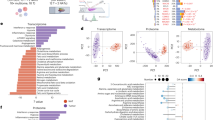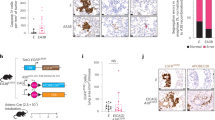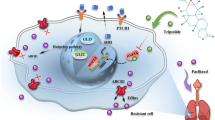Abstract
It is well established that hypoxia contributes to tumor progression in a hypoxia inducible factor-2α (HIF-2α)-dependent manner in renal cell carcinoma (RCC), yet the role of long noncoding RNAs (LncRNAs) involved in hypoxia-mediated RCC progression remains unclear. Here we demonstrate that LncRNA-SARCC (Suppressing Androgen Receptor in Renal Cell Carcinoma) is differentially regulated by hypoxia in a von Hippel-Lindau (VHL)-dependent manner both in RCC cell culture and clinical specimens. LncRNA-SARCC can suppress hypoxic cell cycle progression in the VHL-mutant RCC cells while derepress it in the VHL-restored RCC cells. Mechanism dissection reveals that LncRNA-SARCC can post-transcriptionally regulate androgen receptor (AR) by physically binding and destablizing AR protein to suppress AR/HIF-2α/C-MYC signals. In return, HIF-2α can transcriptionally regulate the LncRNA-SARCC expression via binding to hypoxia-responsive elements on the promoter of LncRNA-SARCC. The negative feedback modulation between LncRNA-SARCC/AR complex and HIF-2α signaling may then lead to differentially modulated RCC progression in a VHL-dependent manner. Together, these results may provide us a new therapeutic approach via targeting this newly identified signal from LncRNA-SARCC to AR-mediated HIF-2α/C-MYC signals against RCC progression.
This is a preview of subscription content, access via your institution
Access options
Subscribe to this journal
Receive 50 print issues and online access
$259.00 per year
only $5.18 per issue
Buy this article
- Purchase on Springer Link
- Instant access to full article PDF
Prices may be subject to local taxes which are calculated during checkout








Similar content being viewed by others
References
Rini BI, Campbell SC, Escudier B . Renal cell carcinoma. Lancet 2009; 373: 1119–1132.
Lipworth L, Tarone RE, McLaughlin JK . The epidemiology of renal cell carcinoma. J Urol 2006; 176: 2353–2358.
Clifford SC, Prowse AH, Affara NA, Buys CH, Maher ER . Inactivation of the von Hippel-Lindau (VHL) tumour suppressor gene and allelic losses at chromosome arm 3p in primary renal cell carcinoma: evidence for a VHL-independent pathway in clear cell renal tumourigenesis. Genes Chromosomes Cancer 1998; 22: 200–209.
Shen C, Kaelin WG Jr . The VHL/HIF axis in clear cell renal carcinoma. Semin Cancer Biol 2013; 23: 18–25.
Yao M, Yoshida M, Kishida T, Nakaigawa N, Baba M, Kobayashi K et al. VHL tumor suppressor gene alterations associated with good prognosis in sporadic clear-cell renal carcinoma. J Natl Cancer Inst 2002; 94: 1569–1575.
Parker AS, Cheville JC, Lohse CM, Igel T, Leibovich BC, Blute ML . Loss of expression of von Hippel-Lindau tumor suppressor protein associated with improved survival in patients with early-stage clear cell renal cell carcinoma. Urology 2005; 65: 1090–1095.
Harrison L, Blackwell K . Hypoxia and anemia: factors in decreased sensitivity to radiation therapy and chemotherapy? Oncologist 2004; 9: 31–40.
Ghosh G, Subramanian IV, Adhikari N, Zhang X, Joshi HP et al. Hypoxia-induced microRNA-424 expression in human endothelial cells regulates HIF-alpha isoforms and promotes angiogenesis. J Clin Invest 2010; 120: 4141–4154.
Harrison LR, Micha D, Brandenburg M, Simpson KL, Morrow CJ, Denneny O et al. Hypoxic human cancer cells are sensitized to BH-3 mimetic-induced apoptosis via downregulation of the Bcl-2 protein Mcl-1. J Clin Invest 2011; 121: 1075–1087.
Harris AL . Hypoxia—a key regulatory factor in tumour growth. Nat Rev Cancer 2002; 2: 38–47.
He D, Li L, Zhu G, Liang L, Guan Z, Chang L et al. ASC-J9 suppresses renal cell carcinoma progression by targeting an androgen receptor-dependent HIF2alpha/VEGF signaling pathway. Cancer Res 2014; 74: 4420–4430.
Chow WH, Dong LM, Devesa SS . Epidemiology and risk factors for kidney cancer. Nat Rev Urol 2010; 7: 245–257.
Gordan JD, Bertout JA, Hu CJ, Diehl JA, Simon MC . HIF-2alpha promotes hypoxic cell proliferation by enhancing C-MYC transcriptional activity. Cancer Cell 2007; 11: 335–347.
Kondo K, Klco J, Nakamura E, Lechpammer M, Kaelin WG Jr . Inhibition of HIF is necessary for tumor suppression by the von Hippel-Lindau protein. Cancer Cell 2002; 1: 237–246.
Kondo K, Kim WY, Lechpammer M, Kaelin WG Jr . Inhibition of HIF2alpha is sufficient to suppress pVHL-defective tumor growth. PLoS Biol 2003; 1: E83.
Raval RR, Lau KW, Tran MG, Sowter HM, Mandriota SJ, Li JL et al. Contrasting properties of hypoxia-inducible factor 1 (HIF-1) and HIF-2 in von Hippel-Lindau-associated renal cell carcinoma. Mol Cell Biol 2005; 25: 5675–5686.
Maxwell PH, Pugh CW, Ratcliffe PJ . Activation of the HIF pathway in cancer. Curr Opin Genet Dev 2001; 11: 293–299.
Cabianca DS, Casa V, Bodega B, Xynos A, Ginelli E, Tanaka Y et al. A long ncRNA links copy number variation to a polycomb/trithorax epigenetic switch in FSHD muscular dystrophy. Cell 2012; 149: 819–831.
Cabili MN, Trapnell C, Goff L, Koziol M, Tazon-Vega B, Regev A et al. Integrative annotation of human large intergenic noncoding RNAs reveals global properties and specific subclasses. Genes Dev 2011; 25: 1915–1927.
Wang KC, Yang YW, Liu B, Sanyal A, Corces-Zimmerman R, Chen Y et al. A long noncoding RNA maintains active chromatin to coordinate homeotic gene expression. Nature 2011; 472: 120–124.
Ding J, Lu Q, Ouyang Y, Mao H, Zhang P, Yao J et al. A long noncoding RNA regulates photoperiod-sensitive male sterility, an essential component of hybrid rice. Proc Natl Acad Sci USA 2012; 109: 2654–2659.
Yang L, Lin C, Liu W, Zhang J, Ohgi KA, Grinstein JD et al. ncRNA- and Pc2 methylation-dependent gene relocation between nuclear structures mediates gene activation programs. Cell 2011; 147: 773–788.
Hung T, Wang Y, Lin MF, Koegel AK, Kotake Y, Grant GD et al. Extensive and coordinated transcription of noncoding RNAs within cell-cycle promoters. Nat Genet 2011; 43: 621–629.
Takahashi K, Yan IK, Haga H, Patel T . Modulation of hypoxia-signaling pathways by extracellular linc-RoR. J Cell Sci 2014; 127: 1585–1594.
Yang F, Zhang H, Mei Y, Wu M . Reciprocal regulation of HIF-1alpha and lincRNA-p21 modulates the Warburg effect. Mol Cell 2014; 53: 88–100.
Yang F, Huo XS, Yuan SX, Zhang L, Zhou WP, Wang F et al. Repression of the long noncoding RNA-LET by histone deacetylase 3 contributes to hypoxia-mediated metastasis. Mol Cell 2013; 49: 1083–1096.
Kretz M, Siprashvili Z, Chu C, Webster DE, Zehnder A, Qu K et al. Control of somatic tissue differentiation by the long non-coding RNA TINCR. Nature 2013; 493: 231–235.
Yu G, Yao W, Wang J, Ma X, Xiao W, Li H et al. LncRNAs expression signatures of renal clear cell carcinoma revealed by microarray. PloS One 2012; 7: e42377.
Mitani T, Yamaji R, Higashimura Y, Harada N, Nakano Y, Inui H . Hypoxia enhances transcriptional activity of androgen receptor through hypoxia-inducible factor-1alpha in a low androgen environment. J Steroid Biochem Mol Biol 2011; 123: 58–64.
Stone L . Prostate cancer: AR targeting-it all makes sense. Nat Rev Urol 2015; 12: 125.
Cockman ME, Masson N, Mole DR, Jaakkola P, Chang GW, Clifford SC et al. Hypoxia inducible factor-alpha binding and ubiquitylation by the von Hippel-Lindau tumor suppressor protein. J Biol Chem 2000; 275: 25733–25741.
Ohh M, Park CW, Ivan M, Hoffman MA, Kim TY, Huang LE et al. Ubiquitination of hypoxia-inducible factor requires direct binding to the beta-domain of the von Hippel-Lindau protein. Nat Cell Biol 2000; 2: 423–427.
Maxwell PH, Wiesener MS, Chang GW, Clifford SC, Vaux EC, Cockman ME et al. The tumour suppressor protein VHL targets hypoxia-inducible factors for oxygen-dependent proteolysis. Nature 1999; 399: 271–275.
Kuo HP, Lee DF, Xia W, Wei Y, Hung MC . TNFalpha induces HIF-1alpha expression through activation of IKKbeta. Biochem Biophys Res Commun 2009; 389: 640–644.
Park SY, Kim YJ, Gao AC, Mohler JL, Onate SA, Hidalgo AA et al. Hypoxia increases androgen receptor activity in prostate cancer cells. Cancer Res 2006; 66: 5121–5129.
Chen Y, Sun Y, Rao Q, Xu H, Li L, Chang C . Androgen receptor (AR) suppresses miRNA-145 to promote renal cell carcinoma (RCC) progression independent of VHL status. Oncotarget 2015; 6: 31203–31215.
Farré D, Roset R, Huerta M, Adsuara JE, Roselló L, Albà MM et al. Identification of patterns in biological sequences at the ALGGEN server: PROMO and MALGEN. Nucleic Acids Res 2003; 31: 3651–3653.
Lu W, Lakonishok M, Gelfand VI . Kinesin-1-powered microtubule sliding initiates axonal regeneration in Drosophila cultured neurons. Mol Biol Cell 2015; 26: 1296–1307.
Moreno-Manzano V, Rodriguez-Jimenez FJ, Acena-Bonilla JL, Fustero-Lardies S, Erceg S, Dopazo J et al. FM19G11, a new hypoxia-inducible factor (HIF) modulator, affects stem cell differentiation status. J Biol Chem 2010; 285: 1333–1342.
Wennemers M, Bussink J, Scheijen B, Nagtegaal ID, van Laarhoven HW, Raleigh JA et al. Tribbles homolog 3 denotes a poor prognosis in breast cancer and is involved in hypoxia response. Breast Cancer Res 2011; 13: R82.
Gordan JD, Lal P, Dondeti VR, Letrero R, Parekh KN, Oquendo CE et al. HIF-alpha effects on C-MYC distinguish two subtypes of sporadic VHL-deficient clear cell renal carcinoma. Cancer Cell 2008; 14: 435–446.
Moon EJ, Brizel DM, Chi JT, Dewhirst MW . The potential role of intrinsic hypoxia markers as prognostic variables in cancer. Antioxid Redox Signal 2007; 9: 1237–1294.
Kulshreshtha R, Ferracin M, Wojcik SE, Garzon R, Alder H, Agosto-Perez FJ et al. A microRNA signature of hypoxia. Mol Cell Biol 2007; 27: 1859–1867.
Linehan WM, Srinivasan R, Schmidt LS . The genetic basis of kidney cancer: a metabolic disease. Nat Rev Urol 2010; 7: 277–285.
Gnarra JR, Tory K, Weng Y, Schmidt L, Wei MH, Li H et al. Mutations of the VHL tumour suppressor gene in renal carcinoma. Nat Genet 1994; 7: 85–90.
Wang J, Zhang W, Ji W, Liu X, Ouyang G, Xiao W . The von hippel-lindau protein suppresses androgen receptor activity. Mol Endocrinol 2014; 28: 239–248.
Claessens F, Alen P, Devos A, Peeters B, Verhoeven G, Rombauts W . The androgen-specific probasin response element 2 interacts differentially with androgen and glucocorticoid receptors. J Biol Chem 1996; 271: 19013–19016.
Rennie PS, Bruchovsky N, Leco KJ, Sheppard PC, McQueen SA, Cheng H et al. Characterization of two cis-acting DNA elements involved in the androgen regulation of the probasin gene. Mol Endocrinol 1993; 7: 23–36.
Verrijdt G, Schoenmakers E, Alen P, Haelens A, Peeters B, Rombauts W et al. Androgen specificity of a response unit upstream of the human secretory component gene is mediated by differential receptor binding to an essential androgen response element. Mol Endocrinol 1999; 13: 1558–1570.
Verrijdt G, Schoenmakers E, Haelens A, Peeters B, Verhoeven G, Rombauts W et al. Change of specificity mutations in androgen-selective enhancers. Evidence for a role of differential DNA binding by the androgen receptor. J Biol Chem 2000; 275: 12298–12305.
Wang X, Arai S, Song X, Reichart D, Du K, Pascual G et al. Induced ncRNAs allosterically modify RNA-binding proteins in cis to inhibit transcription. Nature 2008; 454: 126–130.
Muller H, Klinkhammer W, Globisch C, Kassack MU, Pajeva IK, Wiese M . New functional assay of P-glycoprotein activity using Hoechst 33342. Bioorg Med Chem 2007; 15: 7470–7479.
Acknowledgements
This work was supported by NIH grants (CA155477 and CA156700), George Whipple Professorship Endowment and Taiwan Department of Health Clinical Trial, Research Center of Excellence (DOH99-TD-B-111-004 to China Medical University, Taichung, Taiwan) and the National Science Foundation of China (31570775). We also gratefully acknowledged the help from Mr Jason Walrath of Department of Environmental Medicine of URMC for hypoxia experiments using In ViVo2 hypoxic workstation. We thank Karen Wolf for help preparing the manuscript.
Author information
Authors and Affiliations
Corresponding authors
Ethics declarations
Competing interests
The authors declare no conflict of interest.
Additional information
Supplementary Information accompanies this paper on the Oncogene website
Supplementary information
Rights and permissions
About this article
Cite this article
Zhai, W., Sun, Y., Jiang, M. et al. Differential regulation of LncRNA-SARCC suppresses VHL-mutant RCC cell proliferation yet promotes VHL-normal RCC cell proliferation via modulating androgen receptor/HIF-2α/C-MYC axis under hypoxia. Oncogene 35, 4866–4880 (2016). https://doi.org/10.1038/onc.2016.19
Received:
Revised:
Accepted:
Published:
Issue Date:
DOI: https://doi.org/10.1038/onc.2016.19
This article is cited by
-
A review on the role of long non-coding RNA and microRNA network in clear cell renal cell carcinoma and its tumor microenvironment
Cancer Cell International (2023)
-
Noncoding RNAs as sensors of tumor microenvironmental stress
Journal of Experimental & Clinical Cancer Research (2022)
-
Long noncoding RNAs as tumorigenic factors and therapeutic targets for renal cell carcinoma
Cancer Cell International (2021)
-
Circular RNAs and their role in renal cell carcinoma: a current perspective
Cancer Cell International (2021)
-
Signaling in and out: long-noncoding RNAs in tumor hypoxia
Journal of Biomedical Science (2020)



